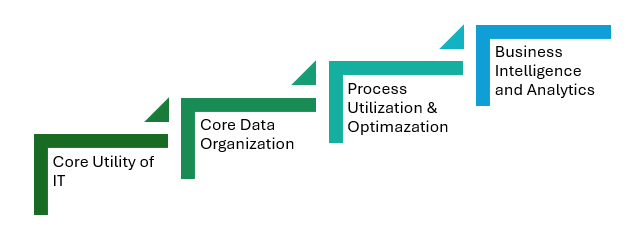Maslow’s Hierarchy of Needs and IT’s Hierarchy

I have been “doing” IT for over 30 years, and throughout this journey, I have often felt that the typical IT conversation—centered solely on “making the systems work”—is incomplete. While it is undeniably important for our systems to function properly so we can get our work done, this approach doesn’t capture the full potential of IT. It is like focusing only on the foundation of a building without considering the structure and design that make it truly functional and beautiful.
For the past 20 years, I have been striving to cast and pursue a vision of something more comprehensive and impactful. Initially, I described our company as “a business consulting firm that specializes in IT.” Although it sounded kind of neat, it often left people more confused than inspired. It was clear that I needed a better way to communicate our vision and approach.
Recently, I was studying about the Fundamentals of Instruction and was re-introduced to Maslow’s Hierarchy of Needs, as a framework, to outline the various needs we have and how they build upon each other. The model starts with the most basic needs like food and water…needs that will kill you quickly if you don’t meet them. From there, it builds into needs for safety then belonging, feeling good about yourself then, finally, at the pinnacle, is self-actualization.
Maslow’s structure can help inform us as we lead our teams. A team member is going to have a hard time pursuing a meaningful career path if they are struggling to put food on the table, their marriage is falling apart and/or they don’t feel connected to a community. Similarly, a student that shows up to class hungry is going to perform at a much lower level than someone that is satisfied, feels safe, etc.
Just as people need to meet their basic needs before they can achieve higher goals, IT also has a hierarchy of needs. This realization was a breakthrough for me, providing a clear framework to articulate how IT can truly support and enhance business operations.
Here is a breakdown of this IT hierarchy, starting from the bottom:
- Core Utility of IT: This is the foundational level. Ensuring that systems turn on, emails are sent, and basic functions work. Most IT firms operate at this level and rarely go beyond it. It is about making sure the technology is reliable and functional, which is essential but only the beginning.
- Core Data Organization: At this level, the focus shifts to organizing data in a way that makes sense and is accessible to the right people while keeping it secure from the wrong ones. This involves setting up proper data management systems, ensuring data integrity, and implementing security measures. Some IT firms reach this level, but many stop here, missing out on the potential for further optimization.
- Process Utilization and Optimization: This level involves integrating IT with business processes to optimize them. It is about using technology to streamline operations, improve efficiency, and reduce costs. This level builds on the first two and is essential for consistent and efficient operations. Without a solid foundation of reliable systems and organized data, process optimization is nearly impossible.
- Business Intelligence and Analytics: At the top of the hierarchy is the ability to analyze organized data to gain insights and intelligence. This level can only be achieved once the previous layers are solid. It is about leveraging data to make informed decisions, identify trends, and drive business growth. This is where IT truly becomes a strategic asset, providing valuable insights that can shape the future of the business.
This hierarchy is still evolving, but it helps us, as a Managed Service Provider (MSP), explain how we serve our clients. We excel at the “Core” layers, which have been the traditional focus of IT firms. However, we add significant value by moving towards and engaging in the process and business intelligence layers, leveraging IT systems to drive business growth and impact. By addressing all levels of the hierarchy, we ensure that our clients not only have reliable and secure systems but also the tools and insights they need to thrive in a competitive market.
This structure is a work in progress. I reserve the right to tweak the wording, add or remove layers, or scrap it entirely if it does not make sense.
I would love to hear your thoughts on this concept. Does it make sense to you? Do you see how this approach could benefit your business? If you would d like to discuss it further or see how it might apply to your specific situation, please reach out, I’d love to connect.
Tags
Let’s Connect
We would love to hear from you. If you have questions about how we may be able to work together, click the button below, fill out the form and we will connect to explore the future together.
